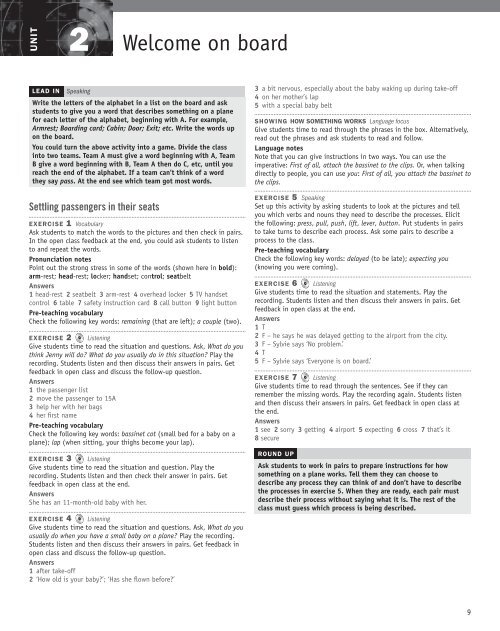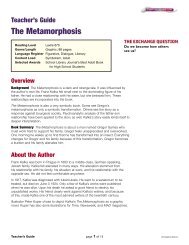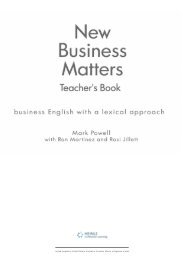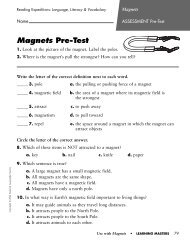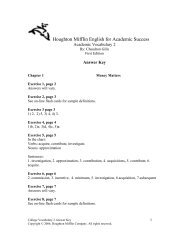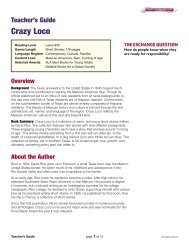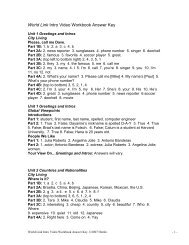English for Cabin Crew Trainer's Guide - Heinle
English for Cabin Crew Trainer's Guide - Heinle
English for Cabin Crew Trainer's Guide - Heinle
You also want an ePaper? Increase the reach of your titles
YUMPU automatically turns print PDFs into web optimized ePapers that Google loves.
UNIT<br />
2 Welcome on board<br />
LEAD IN Speaking<br />
Write the letters of the alphabet in a list on the board and ask<br />
students to give you a word that describes something on a plane<br />
<strong>for</strong> each letter of the alphabet, beginning with A. For example,<br />
Armrest; Boarding card; <strong>Cabin</strong>; Door; Exit; etc. Write the words up<br />
on the board.<br />
You could turn the above activity into a game. Divide the class<br />
into two teams. Team A must give a word beginning with A, Team<br />
B give a word beginning with B, Team A then do C, etc, until you<br />
reach the end of the alphabet. If a team can’t think of a word<br />
they say pass. At the end see which team got most words.<br />
Settling passengers in their seats<br />
EXERCISE 1 Vocabulary<br />
Ask students to match the words to the pictures and then check in pairs.<br />
In the open class feedback at the end, you could ask students to listen<br />
to and repeat the words.<br />
Pronunciation notes<br />
Point out the strong stress in some of the words (shown here in bold):<br />
arm-rest; head-rest; locker; handset; control; seatbelt<br />
Answers<br />
1 head-rest 2 seatbelt 3 arm-rest 4 overhead locker 5 TV handset<br />
control 6 table 7 safety instruction card 8 call button 9 light button<br />
Pre-teaching vocabulary<br />
Check the following key words: remaining (that are left); a couple (two).<br />
EXERCISE 2 Listening<br />
Give students time to read the situation and questions. Ask, What do you<br />
think Jenny will do? What do you usually do in this situation? Play the<br />
recording. Students listen and then discuss their answers in pairs. Get<br />
feedback in open class and discuss the follow-up question.<br />
Answers<br />
1 the passenger list<br />
2 move the passenger to 15A<br />
3 help her with her bags<br />
4 her fi rst name<br />
Pre-teaching vocabulary<br />
Check the following key words: bassinet cot (small bed <strong>for</strong> a baby on a<br />
plane); lap (when sitting, your thighs become your lap).<br />
EXERCISE 3 Listening<br />
Give students time to read the situation and question. Play the<br />
recording. Students listen and then check their answer in pairs. Get<br />
feedback in open class at the end.<br />
Answers<br />
She has an 11-month-old baby with her.<br />
EXERCISE 4 Listening<br />
Give students time to read the situation and questions. Ask, What do you<br />
usually do when you have a small baby on a plane? Play the recording.<br />
Students listen and then discuss their answers in pairs. Get feedback in<br />
open class and discuss the follow-up question.<br />
Answers<br />
1 after take-off<br />
2 ‘How old is your baby?’; ‘Has she fl own be<strong>for</strong>e?’<br />
3 a bit nervous, especially about the baby waking up during take-off<br />
4 on her mother’s lap<br />
5 with a special baby belt<br />
SHOWING HOW SOMETHING WORKS Language focus<br />
Give students time to read through the phrases in the box. Alternatively,<br />
read out the phrases and ask students to read and follow.<br />
Language notes<br />
Note that you can give instructions in two ways. You can use the<br />
imperative: First of all, attach the bassinet to the clips. Or, when talking<br />
directly to people, you can use you: First of all, you attach the bassinet to<br />
the clips.<br />
EXERCISE 5 Speaking<br />
Set up this activity by asking students to look at the pictures and tell<br />
you which verbs and nouns they need to describe the processes. Elicit<br />
the following: press, pull, push, lift, lever, button. Put students in pairs<br />
to take turns to describe each process. Ask some pairs to describe a<br />
process to the class.<br />
Pre-teaching vocabulary<br />
Check the following key words: delayed (to be late); expecting you<br />
(knowing you were coming).<br />
EXERCISE 6 Listening<br />
Give students time to read the situation and statements. Play the<br />
recording. Students listen and then discuss their answers in pairs. Get<br />
feedback in open class at the end.<br />
Answers<br />
1 T<br />
2 F – he says he was delayed getting to the airport from the city.<br />
3 F – Sylvie says ‘No problem.’<br />
4 T<br />
5 F – Sylvie says ‘Everyone is on board.’<br />
EXERCISE 7 Listening<br />
Give students time to read through the sentences. See if they can<br />
remember the missing words. Play the recording again. Students listen<br />
and then discuss their answers in pairs. Get feedback in open class at<br />
the end.<br />
Answers<br />
1 see 2 sorry 3 getting 4 airport 5 expecting 6 cross 7 that’s it<br />
8 secure<br />
ROUND UP<br />
Ask students to work in pairs to prepare instructions <strong>for</strong> how<br />
something on a plane works. Tell them they can choose to<br />
describe any process they can think of and don’t have to describe<br />
the processes in exercise 5. When they are ready, each pair must<br />
describe their process without saying what it is. The rest of the<br />
class must guess which process is being described.<br />
9


